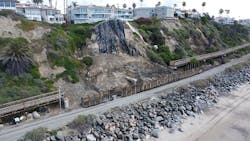Regular passenger rail service to resume on San Clemente rail line March 25
The rail line through San Clemente, Calif., is set to reopen for regular passenger rail service on March 25, as emergency work to build a catchment wall at Mariposa Point in San Clemente to protect the track is finishing construction.
The Orange County Transportation Authority (OCTA) worked in partnership with Metrolink to build a 200-foot-long wall at Mariposa Point to safely re-establish service on the track. On Feb. 20, the California Transportation Commission awarded $7.2 million to OCTA for the construction of the catchment wall. The $7.2 million is in addition to a $2 million previous award from the state of California for cleanup and pre-construction activities at the site.
The emergency construction work was necessitated by a Jan. 24 landslide from a privately-owned hillside that littered the rail right of way below with soil and debris halting rail service.
Metrolink and the LOSSAN Rail Corridor Agency, operator of the Amtrak Pacific Surfliner, are each planning to resume full service on March 25.
Regular passenger rail service was expected to begin in late March or early April. OCTA says full passenger service is being restored ahead of the initial schedule because of expedited work made possible with strong cooperation between the transportation agencies and the state of California, including the California State Transportation Agency.
In the past week, the construction team working at the San Clemente site finished the catchment wall and have continued to work on a more comprehensive drainage system and trenching along the rail right of way. The team also worked in coordination with the city of San Clemente to adjust a sewer access point.
After extensive work, limited Pacific Surfliner passenger service resumed in early March but March 25 will mark the first time regular passenger service has resumed through the area since the initial slide.
For the longer term, OCTA and its rail partners will continue to work with local, state and federal stakeholders on both near-term and long-term solutions for protecting rail movement along the corridor. Work is already under way on the first of two studies. Listening sessions with stakeholders and the public have begun on the OCTA-led Orange County Coastal Rail Resiliency Study, which aims to protect the rail line in place for the next 10 to 30 years.
